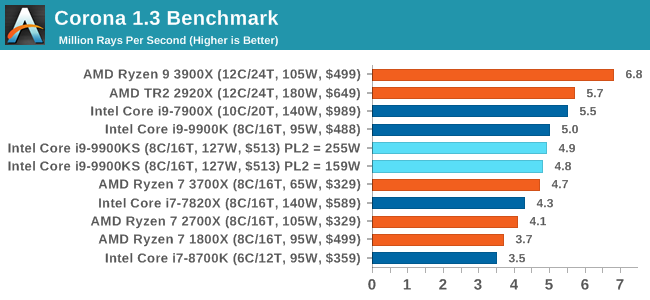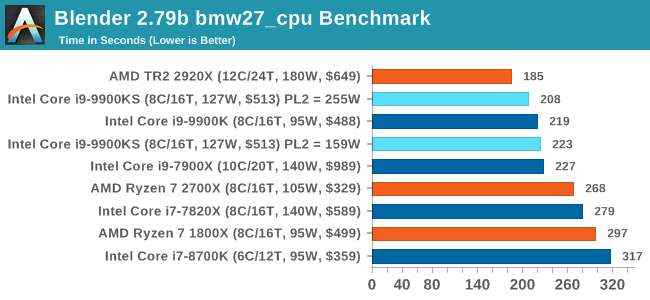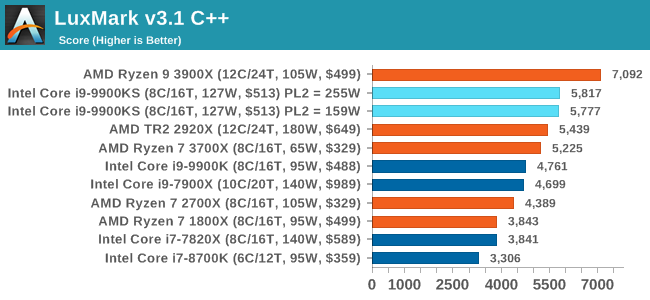The Intel Core i9-9900KS Review: The 5 GHz Consumer Special
by Dr. Ian Cutress on October 31, 2019 10:45 AM ESTCPU Performance: Rendering Tests
Rendering is often a key target for processor workloads, lending itself to a professional environment. It comes in different formats as well, from 3D rendering through rasterization, such as games, or by ray tracing, and invokes the ability of the software to manage meshes, textures, collisions, aliasing, physics (in animations), and discarding unnecessary work. Most renderers offer CPU code paths, while a few use GPUs and select environments use FPGAs or dedicated ASICs. For big studios however, CPUs are still the hardware of choice.
All of our benchmark results can also be found in our benchmark engine, Bench.
Corona 1.3: Performance Render
An advanced performance based renderer for software such as 3ds Max and Cinema 4D, the Corona benchmark renders a generated scene as a standard under its 1.3 software version. Normally the GUI implementation of the benchmark shows the scene being built, and allows the user to upload the result as a ‘time to complete’.
We got in contact with the developer who gave us a command line version of the benchmark that does a direct output of results. Rather than reporting time, we report the average number of rays per second across six runs, as the performance scaling of a result per unit time is typically visually easier to understand.
The Corona benchmark website can be found at https://corona-renderer.com/benchmark

Interestingly both 9900KS settings performed slightly worse than the 9900K here, which you wouldn't expect given the all-core turbo being higher. It would appear that there is something else the bottleneck in this test.
Blender 2.79b: 3D Creation Suite
A high profile rendering tool, Blender is open-source allowing for massive amounts of configurability, and is used by a number of high-profile animation studios worldwide. The organization recently released a Blender benchmark package, a couple of weeks after we had narrowed our Blender test for our new suite, however their test can take over an hour. For our results, we run one of the sub-tests in that suite through the command line - a standard ‘bmw27’ scene in CPU only mode, and measure the time to complete the render.
Blender can be downloaded at https://www.blender.org/download/

All the 9900 parts and settings perform roughly the same with one another, however the PL2 255W setting on the 9900KS does allow it to get a small ~5% advantage over the standard 9900K.
LuxMark v3.1: LuxRender via Different Code Paths
As stated at the top, there are many different ways to process rendering data: CPU, GPU, Accelerator, and others. On top of that, there are many frameworks and APIs in which to program, depending on how the software will be used. LuxMark, a benchmark developed using the LuxRender engine, offers several different scenes and APIs.
In our test, we run the simple ‘Ball’ scene on both the C++ and OpenCL code paths, but in CPU mode. This scene starts with a rough render and slowly improves the quality over two minutes, giving a final result in what is essentially an average ‘kilorays per second’.

Both 9900KS settings perform equally well here, and a sizeable jump over the standard 9900K.
POV-Ray 3.7.1: Ray Tracing
The Persistence of Vision ray tracing engine is another well-known benchmarking tool, which was in a state of relative hibernation until AMD released its Zen processors, to which suddenly both Intel and AMD were submitting code to the main branch of the open source project. For our test, we use the built-in benchmark for all-cores, called from the command line.
POV-Ray can be downloaded from http://www.povray.org/

One of the biggest differences between the two power settings is in POV-Ray, with a marked frequency difference. In fact, the 159W setting on the 9900KS puts it below our standard settings for the 9900K, which likely had an big default turbo budget on the board it was on at the time.











235 Comments
View All Comments
Jorgp2 - Thursday, October 31, 2019 - link
Did you actually read the article?Korguz - Thursday, October 31, 2019 - link
um.. it is a 172w cpu.... did you read it jorgp2 ?? intel tdp... is crap.. this is listed as being a 127 w cpu.. at BASE frequency. at 5ghz... it will probably use 172 w.. or morevMax65 - Friday, November 1, 2019 - link
Err...no...der8aur jus tested the 9900KS and it runs games all core 5GHz at between 98w and 126w....Video showing this starts at 3:50..It just depends on what you are doing and whether you are using heavy compute applications but for most games and normal day to day usage no it will hapily run under well under 172w... and that will never be an issue and that's really where this CPU is targeted...albeit those with deeper pockets...https://www.youtube.com/watch?v=YWSn0cHauJ4
Korguz - Friday, November 1, 2019 - link
what was his test setup ??? does it state that ?? i dont see how this chip can use less power. then its own siblings.GreenReaper - Saturday, November 2, 2019 - link
It's possible that it is if the chip is more power efficient (i.e. needs a lower voltage for a given load), which it has to be just to reach 5Ghz on all cores without sending power through the roofDigitalFreak - Friday, November 1, 2019 - link
Yep, I did. Their testing showed that all cores running at 5Ghz had the CPU using 172W. If you're not going to keep all cores running at 5Ghz, except during idle, what's the point of buying this over a 9900K?vMax65 - Friday, November 1, 2019 - link
I am not sure how you missed it but he clearly says when running CSGO, SOTTR and even Timespy GT1 and GT2 the CPU is always at all core 5GHz all the time with max power draw between 75w and a 126w.....He clearly states that at 4 minutes and onwards...The only time this CPU will draw max power of 170w is when you are doing heavy duty compute loads or testing with AVX...For normal use like gaming...this is what most people will buy it for it will never be at 170w plus..
Korguz - Friday, November 1, 2019 - link
again.. you dont state what the test setup was. how it was configured.. so, either he did something wrong, or anandtech did, and sorry to say, i trust AT more...vMax65 - Saturday, November 2, 2019 - link
Asus z390 maximus xi extreme, RTX 2080Ti and not sure what RAM...but as he cleary states this was during the bechmark runs and in the comments he covers forgetting to mention the 2080Ti but clarifies this point. Bottom line for 'normal' gaming usage this CPU will run all core 5GHz all the time at on or under 127w...vMax65 - Saturday, November 2, 2019 - link
And Anandtech tested power with Cinebench...not with games....